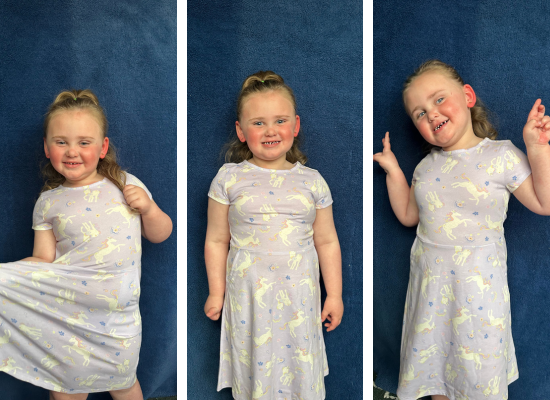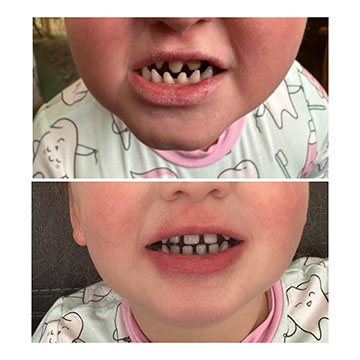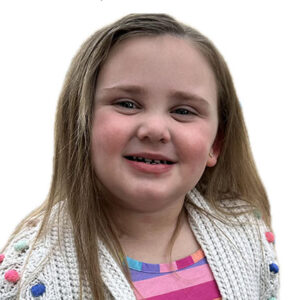Five-year-old Brooklyn loves her new, “fancy” teeth.
That’s what she called them when she looked in the mirror for the first time after receiving new stainless steel crowns on seven of her baby teeth last month.
“Brooklynn said that she was so rich, she has silver teeth!” recalled her mom, Ashley.

The spirited young girl needed the crowns to protect her teeth. Her tooth enamel is thinner and softer due to ectodermal dysplasia, which can lead to cavities. The crowns also reshaped her small, pointy teeth so they have a more normal size and shape for better function. The teeth in front have a special “window” over the teeth so that the teeth appear white instead of silver.
A Diagnosis That Sparked a Journey
Brooklynn’s dental journey began at nine months old. Her first two teeth came in sharp and pointy. Their pediatrician, recalling a child affected by ectodermal dysplasia from his residency, referred the family to genetic testing.
The results confirmed it. Brooklynn has the WNT10a gene linked to three different types of ectodermal dysplasia. But the genetics counselor could not tell Brooklynn’s parents, Ashley and Jason, which one she has.
That lack of a definitive answer was understandably upsetting. With a medical background, Ashley likes to research as much information as she can and be prepared for what Brooklynn might experience.
Despite living in a small northern Michigan town, support and answers came quickly. Through a friend, Ashley connected with another mom whose child was affected by ectodermal dysplasia. That connection led her to the National Foundation for Ectodermal Dysplasias (NFED).
“I found that the NFED was so versed in resources and signed up to receive many of them to my email right away,” Ashley said.
The other mom also connected the family to Dr. Gonzo Herndadez, a dentist in Appleton, Wisconsin who had experience treating children with ectodermal dysplasias. It meant a 90-minute drive each way but it was worth it for Ashley and her husband, Jason. He gave them different things to look for as Brooklynn’s teeth erupted and developed.

As Brooklynn grew, so did the challenges. She was missing teeth, had wide gaps and by age three, cavities were becoming an issue because of the soft enamel. When she would fall down or bump her face, her pointy teeth would sometimes puncture a hole in her lip. Dr. Hernandez created a treatment plan for crowns to preserve and reshape the teeth.
Determining If the Treatment Plan Was the Right One
Ashley took action to gather more information to make sure it was the right treatment for their daughter. She read articles and watched a dental treatment webinar on the NFED website.
“I was very careful about when we were going to have the treatment done. I really wanted to know, is she going to have permanent teeth where I have to do all of this again? Because we’re talking $10,000. If she’s just going to lose these teeth, why are we spending all this money on baby teeth?”
They also had to find a way to pay for the care. Using tips from the NFED’s Insurance Toolkit, the diligent mom pored over her medical insurance policy and made numerous calls.
“My medical insurance has a clause written in it that they will not cover anything related to dental unless it’s an accident,” Ashley said. “So, if you got hit in the face with a baseball, sure, they’re going to replace your teeth. But, if you have a congenital anomaly, they’re not going to touch any bill. Even with anesthesia we had to pay out of pocket.”
Jason and Ashley received funding from the NFED’s Treatment Assistance Program, launched a GoFundMe and pressed forward. Before finalizing the plan, they waited until Brooklynn was old enough to have a panoramic x-ray to check for adult teeth.
The news was not what they wanted to hear.
“Dr. Gonzo said, ‘there’s nothing there’ and that’s when I made the executive decision that I’m scheduling this surgery,” Ashley said. “She’s going to have it done because she’s going to be with these teeth for the next 18-21 years.”
Achieving Better Function

Ashley said the dentist felt stainless steel crowns were the best option for longevity. She and Jason wanted Brooklynn to have functional, healthy teeth before she started kindergarten.
No parent wants to see their child get bullied for something that is completely out of their control. However, having a child that we know has zero permanent teeth, it was important to do everything in our power to preserve the primary teeth she has as well as give her the functionality to eat, chew, and receive the nutrients she needs to remain healthy. – Ashley
Brooklynn’s journey is just beginning. She will likely need full dentures when she’s older. Jason said he will be able to help her through that process when the time comes since he also wears dentures.
For now, she’s eating foods more easily.
Smiling With Confidence
Ashley never noticed that Brooklynn didn’t smile showing her teeth until after her treatment. Her newfound confidence is evident.
“We’ve been telling her to show people her teeth, because it’s a big change, and it’s a big deal. I think she should be proud of it. We brought her to an ice fishing derby and she was showing a couple of people her new teeth. After they said something nice to her, you could tell that her whole demeanor had changed. She was just having a ball and smiling big with her teeth. I guess I never knew that she didn’t before. But now you can really see it. It’s hard to know that she knew there was a difference. But it’s good to know that she’s getting confident.”
Seeing Brooklynn’s radiant smile these days, she knows they made the right decision. She also hopes to inspire advocacy. Ashley plans to advocate for the Ensuring Lasting Smiles Act so their family can hopefully have benefits for Brooklyn’s future dental care.
Brooklynn’s dazzling smile is proof of what determination, love and advocacy can achieve. And as she continues to grow, one thing is clear – she’s going to shine inside and out.
Treatment Assistance Program
If you or your loved one needs financial assistance for dental care, genetic testing, wigs or air conditioning, consider applying for the NFED’s Treatment Assistance Program.
Learn MoreShare Your Story
Would you like your experience with ectodermal dysplasia to be featured in our blog?
Submit Your Amazing Story
Can you clarify why they weren’t able to identify which type of WNT10a she had?
Hi Katherine, we’re not exactly sure why Brooklynn’s geneticist was not able to identify the type of WNT10A she has. Since she has the gene linked to 3 different types of ectodermal dysplasia, it can be quite difficult to identify due to the rarity of the condition.
I have this genetic condition i had similar teeth to Brooklyn but mine were more widely spaced. After reading about Brooklyn being conscious about her smile, I remember I always covered my mouth with my hand when I smiled, I never really thought about it before
Hi Ann, thank you for reading our blog post and for sharing your experience!